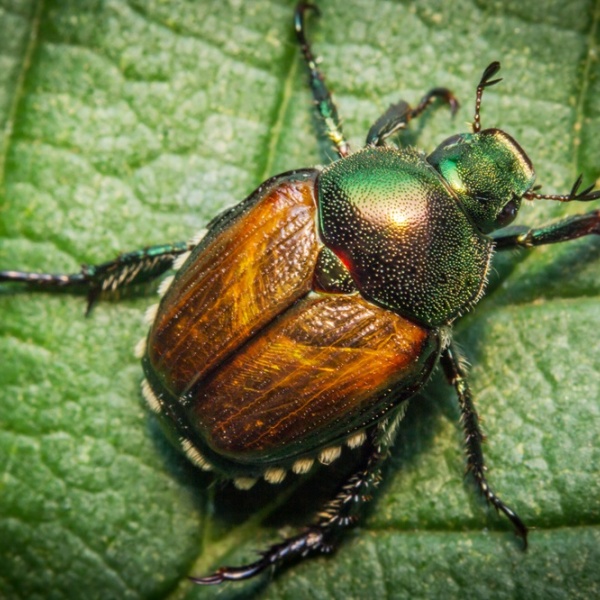Japanese beetle, Popillia japonica (Newman), is a destructive plant pest that was introduced to eastern North America from Japan in 1916, and then to Canada in 1939.
Although treatment programs have been unable to completely eliminate this pest from Canada, annual trappings have been very effective in detecting infestations.
Japanese beetle causes damage during 2 phases of its life cycle.
- In the fall or spring, look for signs larvae damage.
- From late June to mid-October, look for signs of damage from adult beetles.
How to spot it
Signs of larvae damage
When the larvae feed on grass roots, it results in patches of brown dead grass, which may feel spongy and can be easily pulled away.
Larvae feed on a wide variety of plant roots, reducing the plant's intake of water and nutrients. In this stage of development, the beetles like to eat grass, ornamentals, shrubs, and garden crops.
Signs of adult damage
The adults are skeletonizers – they eat the leaf tissue and leave the veins behind. Attacked leaves look like lace that soon withers and dies. They will often attack flower buds and fruit.
Japanese beetle adults will heavily feed on over 300 plant species, including landscape and ornamental plants, nursery stock and food plants found in fruit and vegetable gardens, orchards and agricultural crops.
Preferred host trees
Preferred Japanese beetle hosts include:
- elm trees
- maple trees
- roses
- grapevines
- fruit trees (including peach, apple, apricot, cherry and plum trees)
- blueberries, raspberries, blackberries and other small fruit
Where it is
Japanese beetle is established in Ontario, Quebec, New Brunswick, Nova Scotia and Prince Edward Island. Visit your local nursery to learn how to manage it on your property.
If you find signs of Japanese beetle in Manitoba, Saskatchewan, Alberta or the territories, report it to the Canadian Food Inspection Agency (CFIA).
Response in British Columbia
The province of British Columbia is the only Category 1 Japanese beetle pest-free area in Canada. The CFIA is collaborating with the provincial Ministry of Agriculture and Food, municipalities, industry and other non-governmental stakeholders to prevent its spread and maintain the province's pest-free status.
Find out more about Japanese beetle in British Columbia including:
- how to report sightings
- how to apply for a movement certificate, and
- more about the ongoing response to Japanese beetle.
Response in Newfoundland
The province of Newfoundland and Labrador is working with the CFIA, the City of St-John's and industry stakeholders to respond to increased detections of Japanese beetle in the St. John's area.
Find out more about Japanese beetle in Newfoundland and Labrador.



